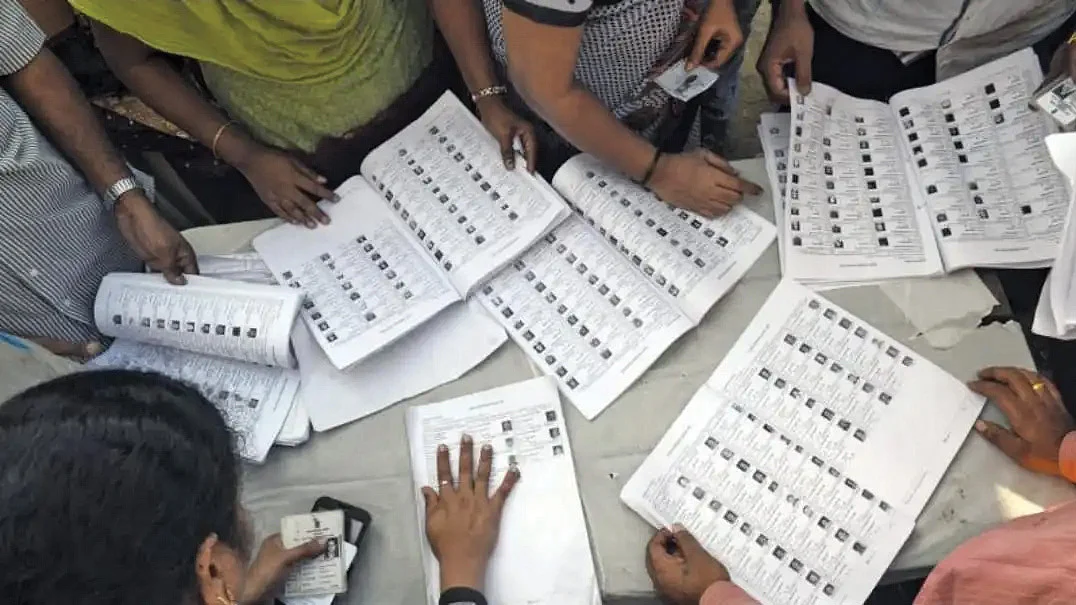Who’s afraid of the SIR in Maharashtra?
Not unexpectedly, the Election Commission of India and the Chief Electoral Officer (CEO) of Maharashtra maintained their sphinx-like silence

A fresh round of protests in Mumbai against the voter-list fraud was met with official silence. Denied permission to hold a rally on 1 November, thousands of workers and supporters of the Maha Vikas Aghadi (MVA) marched to the office of the Brihanmumbai Municipal Corporation (BMC) where leaders addressed the gathering from a makeshift truck-mounted dais.
The high point of the protest was the (second) coming together of estranged cousins Uddhav and Raj Thackeray, who formally announced their alliance. Congress leaders and workers joined the protest, effectively ending speculation that they would not share a platform with Raj Thackeray.
Not unexpectedly, the Election Commission of India and the Chief Electoral Officer (CEO) of Maharashtra maintained their sphinx-like silence. Despite mounting evidence of errors in voters’ lists—including claims by Raj Thackeray that voters from Kalyan and Bhiwandi were also registered as voters in Malabar Hill in Mumbai—there was no response from the ECI.
Again, not unexpectedly, chief minister Devendra Fadnavis jumped in to defend the ECI, dismissing the allegations as frivolous. On the same day as the MVA rally, the BJP organised a counter protest to register the grouse that the Opposition’s target was not so much the ECI but the BJP.
Fadnavis went a few steps further. People, he said, frequently change addresses, jobs and even cities. Thus, it was not unusual for the same voters’ names to appear in different constituencies. An act of fraud could only be established if there was proof of their voting in more than one constituency.
While people hotly debated the feasibility of anyone casting a vote in Malabar Hill and in Kalyan on the same day, the chief minister missed one crucial point. The registration procedure requires voters who change constituencies to provide details of their previous booth, and the ECI must confirm the deletion of old entries before adding new ones.
This legality raises pressing questions about how thousands of duplicate voter entries found their way into the revised electoral rolls issued by the ECI in Maharashtra in July 2025. The addition of a large number of so-called voters after the Lok Sabha election in May 2024 came to light after the assembly election in November.
Once bitten twice shy, the Opposition MVA is determined to escalate the issue well in time—before the BMC and other local body elections which the Supreme Court has mandated be held by January 2026. Since elections are already overdue by three years, the MVA argues that the ECI should first verify and correct the electoral rolls before proceeding with the polls.
The question the MVA asks is simple: why is the ECI not holding a Special Intensive Revision (SIR) of electoral rolls in Maharashtra? Why is SIR 2.0 being rolled out only in 12 states? When discrepancies in Maharashtra’s voter lists—from January 2024 to July 2025—are already in the public domain, and opposition parties have verified the rolls, uncovering duplications, suspicious additions and fake voters, why has a Special Inquiry Report (SIR) not been initiated?
Speaking to the gathering on 1 November, Shiv Sena (UBT) chief Uddhav Thackeray said someone had attempted to delete his name from the voters’ list by using the ECI’s Saksham app. It was only when Election Commission officials visited Matoshree (the Thackeray family residence) to investigate the matter that it became clear that a fake mobile number had been used.
Readers will recall that on 27 October Aaditya Thackeray had exposed as many as 22,000 irregularities in the Worli assembly constituency alone, where some voters’ names are incorrectly spelled, while others’ genders have been changed. In a detailed presentation akin to Rahul Gandhi’s exposés, Aaditya Thackeray cited the example of 48 voters registered at the same address in Worli.
Also in Worli, 46 voters, all of them named Ghasita Ram Halwai, are registered at the same non existent address. In another instance, one Narhari Kulkarni who was declared dead in the Lok Sabha election cast his vote in the Assembly election after which his name was deleted. Raj Thackeray shared a list of 4,500 voters who live in Kalyan Rural, Dombivali, Murbad and Bhiwandi who also cast their votes in the Malabar Hill constituency.
The list included 62,370 names in Mumbai North, 60,231 in Mumbai North West, 92,983 in Mumbai North East, 63,740 in Mumbai North Central, 50,565 in Mumbai South Central, 55,205 in Mumbai South, 99,673 in Nashik, 100,000 in Pune and 200,000 in Thane Lok Sabha constituencies. Ironically, the concern is not confined to the Opposition.
State ministers Sanjay Shirsat from the Shinde faction and Hasan Mushrif of the Ajit Pawar faction have also gone on record to say this is an issue across Maharashtra that urgently needs to be corrected. Despite pressures from all sides, the BJP and the ECI show no sign of initiating an SIR—whose purported role is correction.
With the next Maharashtra assembly election not due for another four years, the demand for electoral roll integrity ahead of these constitutionally overdue local polls marks a new flashpoint in the ongoing saga of SIR 2.0.
Follow us on: Facebook, Twitter, Google News, Instagram
Join our official telegram channel (@nationalherald) and stay updated with the latest headlines
